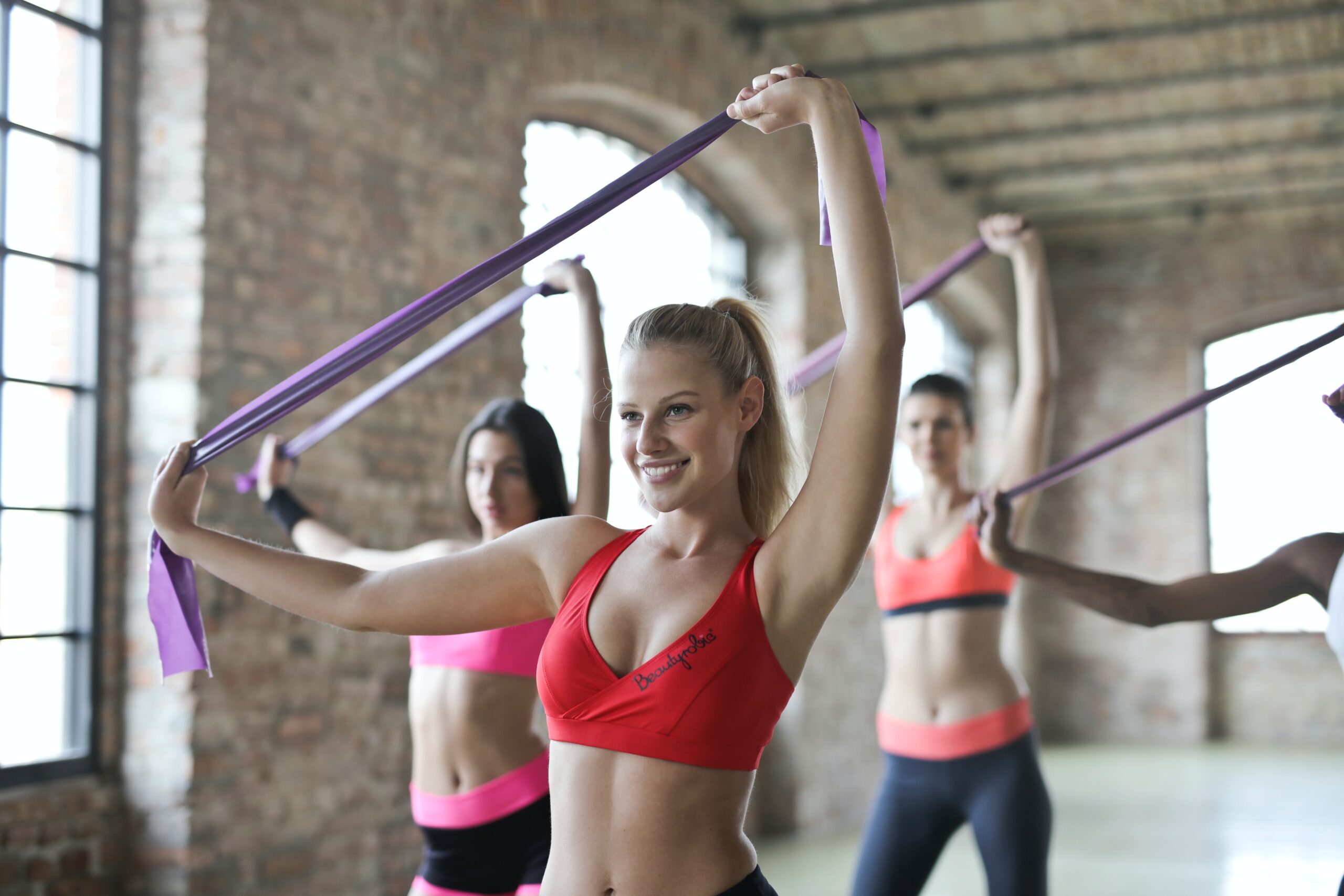Are you struggling to find the perfect exercise routine that suits your needs and goals? Look no further! In this blog post, I will guide you through the process of creating a well-rounded fitness plan that will keep you motivated and help you achieve your desired results.
When it comes to fitness, it’s important to include a variety of exercises to target different aspects of your health and well-being. Aerobic fitness, strength training, core exercises, balance training, and flexibility and stretching should all be part of your routine. Whether you enjoy walking, dancing, lifting weights, or practicing yoga, there are endless options to choose from.
But how do you know which exercises are right for you? That’s where I come in! By taking an exercise quiz, you can receive personalized recommendations based on your fitness goals, preferences, and physical abilities. This will ensure that your workout routine is tailored to your specific needs and gradually increases over time.
Before starting any new exercise routine, it’s always a good idea to consult with a fitness professional or doctor. They can provide guidance and ensure that you’re engaging in activities that are safe and suitable for your current fitness level. So what are you waiting for? Let’s find your ideal exercise routine and start your fitness journey today!

- A well-rounded fitness training plan should include aerobic fitness, strength training, core exercises, balance training, and flexibility and stretching.
- It is recommended to set SMART goals (specific, measurable, attainable, relevant, and timely) for fitness.
- The recommended exercises should be tailored to an individual’s fitness level and gradually increase over time.
- It is important to consider one’s interests and enjoyment when choosing an exercise routine.
- Consulting with a fitness professional or doctor is advisable before starting a new exercise routine.
Understanding the Components of a Well-Rounded Fitness Plan
When it comes to fitness, it’s important to have a well-rounded training plan that includes a variety of components. By incorporating different exercises and activities into your routine, you can target different areas of fitness and maximize your overall health and wellness. In this section, we will explore the key components of a well-rounded fitness plan and the benefits they provide.
Importance of Aerobic Fitness
Aerobic fitness, also known as cardiovascular fitness, is a crucial component of any fitness plan. Engaging in aerobic activities such as walking, jogging, biking, swimming, or dancing can improve your cardiovascular health and increase your endurance. Aim for at least 150 minutes of moderate aerobic activity or 75 minutes of vigorous aerobic activity per week. Regular aerobic exercise can lower the risk of chronic diseases, improve lung and heart function, and boost your mood.
Benefits of Strength Training
Strength training is another essential component of a well-rounded fitness plan. By incorporating resistance machines, free weights, or bodyweight exercises into your routine, you can increase your muscle strength and endurance, improve bone density, and enhance your overall body composition. Strength training can also aid in weight management by boosting your metabolism and helping you burn calories more efficiently.
Core Exercises for Stability
Improving core strength is crucial for stability and overall body movement. Core exercises, such as bridges, planks, sit-ups, and fitness ball exercises, target the muscles in your stomach area and help improve your posture, balance, and coordination. By incorporating core exercises into your fitness routine, you can enhance your overall stability and prevent injuries.
Enhancing Balance Through Training
Maintaining balance becomes increasingly important as we age, as it can help prevent falls and maintain independence. Balance training exercises, such as standing on one leg or practicing tai chi, can improve your balance and coordination. These exercises challenge your body’s ability to maintain equilibrium and can significantly benefit people of all ages.
The Role of Flexibility and Stretching
Flexibility and stretching exercises should not be overlooked in a well-rounded fitness plan. Stretching helps increase flexibility, improve joint range of motion, and promote better posture. It is recommended to include stretching exercises after your workout when your muscles are warm. By incorporating flexibility exercises into your routine, you can reduce the risk of injury, improve athletic performance, and enhance overall mobility.
In conclusion, a well-rounded fitness plan should include aerobic fitness, strength training, core exercises, balance training, and flexibility exercises. By incorporating these components into your routine, you can target different areas of fitness and achieve overall health and wellness. Remember to tailor your exercise routine to your age, goals, and lifestyle, and consult with a fitness professional or doctor before starting a new exercise program.
For more information on building your own workout routine, check out this helpful resource that provides guidance and personalized recommendations based on your fitness goals, preferences, and physical abilities. Remember to choose exercises that you enjoy and find interesting, as this will increase your motivation and adherence to your fitness plan. Stay committed, stay consistent, and enjoy the journey towards a healthier, fitter you!
Designing Your Fitness Routine Based on Goals and Lifestyle
When it comes to designing a fitness routine, it’s important to consider your goals and lifestyle. A well-rounded fitness training plan should include various elements such as aerobic fitness, strength training, core exercises, balance training, and flexibility and stretching. These components work together to improve overall fitness and promote long-term health.
Factors to consider
Before diving into designing your fitness routine, there are a few factors you should consider. These include your age, goals, nutritional strategy, and free time. Age plays a role in determining the intensity and types of exercises that are suitable for you. Your goals will help guide the focus of your routine, whether it’s building muscle, losing weight, improving cardiovascular fitness, or a combination of these. Your nutritional strategy can also influence the type and timing of your workouts. Lastly, your free time availability will determine how often and for how long you can commit to exercise.

Setting SMART fitness goals
To ensure that your fitness routine is effective and motivating, it’s important to set SMART goals. SMART stands for specific, measurable, attainable, relevant, and timely. By setting specific goals, you can clearly define what you want to achieve. Measurable goals allow you to track your progress and stay motivated. It’s important to set goals that are attainable and realistic based on your current fitness level and lifestyle. Relevant goals are those that align with your overall health and well-being. Lastly, setting a timeline for your goals helps create a sense of urgency and accountability.
Determining time availability
One of the key factors in designing your fitness routine is determining the amount of time you can dedicate to exercise. This will depend on your schedule and lifestyle. Some individuals may have more flexibility and can commit to longer workouts, while others may have limited time and need to find ways to incorporate exercise into their daily routines. It’s important to find a balance that works for you and allows you to consistently engage in physical activity.
Weight training for muscle and weight management
Weight training is an essential component of a well-rounded fitness routine, whether your goal is to build muscle or manage weight. Weight training can be done with resistance machines, free weights, or bodyweight exercises. It helps increase bone strength, improve muscle fitness, and can aid in weight management. By incorporating weight training into your routine, you can increase your metabolism, burn more calories, and achieve a toned physique.
Efficient compound exercises
When it comes to strength training, it’s important to focus on efficient compound exercises. Compound exercises recruit multiple muscle groups, making them more time-efficient and effective compared to isolation exercises. Examples of compound exercises include squats, deadlifts, bench presses, and pull-ups. By incorporating these exercises into your routine, you can target multiple muscle groups at once, improving overall strength and muscle development.
Wrapping Up
Designing a fitness routine that aligns with your goals and lifestyle is crucial for long-term success. By considering factors such as your age, goals, time availability, and incorporating elements like weight training and compound exercises, you can create a personalized routine that maximizes results. Remember to set SMART goals, stay consistent, and consult with a fitness professional or doctor if needed. With the right approach, you can achieve your fitness goals and improve your overall health and well-being.
Choosing the Right Sets, Reps, and Rest Periods
Finding the right sets, reps, and rest periods for your exercise routine is essential for maximizing your results and avoiding injuries. With so many options to choose from, it can be overwhelming to determine the best approach. In this section, we will explore some guidelines and recommendations to help you make informed decisions about your workout structure.
Recommended sets and reps
When it comes to strength training, the number of sets and reps you perform can greatly impact your progress. It’s important to strike a balance between challenging yourself and avoiding overexertion. A common starting point is 3-5 sets of 8-10 reps per exercise. This range allows for sufficient volume to stimulate muscle growth while maintaining proper form and technique.
However, keep in mind that these numbers can vary depending on your fitness level and goals. If you’re a beginner, you may want to start with lighter weights and higher reps to focus on building a solid foundation. On the other hand, if you’re more experienced and aiming for strength gains, you might opt for heavier weights and lower reps. It’s always a good idea to consult with a fitness professional or trainer to tailor your sets and reps to your specific needs.
Rest time guidelines
Rest periods between sets play a crucial role in your workout. The amount of time you rest depends on the intensity of the exercise and your fitness goals. Generally, compound exercises that recruit multiple muscle groups, such as squats or deadlifts, require longer rest periods compared to isolation exercises.
For strength and muscle building, it’s recommended to rest for about 1-3 minutes between sets. This allows your muscles to recover and replenish energy before the next set. On the other hand, if your goal is to improve muscular endurance and cardiovascular fitness, shorter rest periods of around 30-60 seconds can keep your heart rate elevated and challenge your stamina.
Remember, these are general guidelines, and you can adjust the rest times based on your individual needs and preferences. Pay attention to how your body feels during your workouts and make adjustments accordingly.
Progressive weight increments
Progressive overload is a key principle in strength training. It involves gradually increasing the amount of weight you lift over time to continually challenge your muscles and stimulate growth. When choosing the appropriate weight, it should be challenging enough to complete the desired number of reps with proper form, but not so heavy that it compromises your technique.
Start with a weight that allows you to comfortably complete your desired reps for each set. As you become stronger and more confident, gradually increase the weight in small increments. This progressive approach will help you avoid plateaus and continue making progress toward your goals. Remember, consistency is key, so be patient and persistent in your journey.
Duration of an effective workout
While the duration of a workout can vary depending on individual preferences and schedules, it’s generally recommended to aim for a session lasting 45 minutes to an hour. This includes warm-up exercises, your main workout, and cool-down stretches. This timeframe allows for an adequate amount of time to target different muscle groups, maintain intensity, and prevent overexertion.
However, it’s important to prioritize quality over quantity. A well-structured and efficient workout can be more effective than a longer one filled with ineffective exercises or excessive rest periods. Focus on performing each exercise with proper form and technique, and listen to your body’s signals to prevent overtraining or burnout.
Exploring supersets and circuit training
For those looking to add variety and intensity to their workouts, incorporating supersets and circuit training can be beneficial. Supersets involve performing two exercises back-to-back without rest, targeting different muscle groups. This technique increases the challenge and keeps your heart rate elevated, leading to greater calorie burn and improved cardiovascular fitness.
Circuit training, on the other hand, combines multiple exercises into a continuous sequence, with minimal rest between each exercise. This method not only improves strength and endurance but also adds an element of cardiovascular conditioning. It’s an effective way to maximize your time and target multiple fitness components within a single workout.
Both supersets and circuit training can be great options for burning fat and improving overall fitness. However, they may not be suitable for everyone, especially beginners or individuals with certain health conditions. It’s important to start gradually and listen to your body’s response to determine if these techniques are suitable for you.
In conclusion, choosing the right sets, reps, and rest periods is crucial for designing an effective exercise routine. By considering your fitness goals, preferences, and individual needs, you can create a workout plan that optimizes your results and keeps you motivated. Remember to track your progress, seek guidance when needed, and enjoy the journey towards a healthier and fitter you.
Reference: Nerd Fitness
Creating a Consistent Workout Schedule
When it comes to fitness, finding the ideal exercise routine can be a daunting task. With so many options and recommendations available, it’s easy to feel overwhelmed and unsure of where to start. However, by considering a few key factors and utilizing some helpful tools, you can create a consistent workout schedule that suits your needs and helps you achieve your fitness goals.
Frequency of training
One important aspect of creating an exercise routine is determining how often you should train. According to experts, it is recommended to aim for 2-3 training sessions per week, with at least 48 hours of rest between workouts. This rest period allows your muscles to recover and adapt to the physical stress of exercise. It’s important to note that rest and recovery are just as crucial as the actual training itself, as they allow your body to repair and grow stronger.
Importance of rest and recovery
Rest and recovery play a vital role in any fitness program. It’s during these periods of rest that your body repairs damaged tissues, replenishes energy stores, and adapts to the physical demands of exercise. Without adequate rest and recovery, you increase your risk of injury, burnout, and overtraining. So, make sure to listen to your body and give yourself time to rest and recover between workouts.
Tracking progress for motivation
Tracking your progress is an essential part of staying motivated and seeing results. By keeping a record of your workouts, you can see how far you’ve come and track your improvements over time. This can be as simple as writing down the exercises you perform, the number of sets and reps, and the amount of weight lifted. Additionally, you can utilize fitness apps or wearable devices to track metrics such as heart rate, distance covered, and calories burned. These tools can provide valuable insights and help you stay accountable to your fitness goals.
The option of guided or customized plans
When it comes to creating a workout routine, you have the option of going with a guided or customized plan. A guided plan typically involves following a structured program or workout routine designed by a fitness professional. This can be beneficial for beginners or those who prefer a more structured approach. On the other hand, a customized plan allows you to tailor your workouts to your specific needs and preferences. This can be done with the help of a fitness professional or by utilizing online resources and apps that provide personalized recommendations based on your goals, fitness level, and preferences.
Utilizing exercise quizzes for recommendations
If you’re unsure where to start or what type of exercises would be best for you, you can take advantage of exercise quizzes. These quizzes ask a series of questions about your fitness goals, preferences, and physical abilities to provide personalized recommendations. By taking an exercise quiz, you can get a better understanding of the types of exercises that would be most beneficial for you and your fitness journey. One example of an exercise quiz can be found here.
In conclusion, creating a consistent workout schedule can be a challenging but rewarding process. By considering factors such as frequency of training, the importance of rest and recovery, tracking progress, and utilizing guided or customized plans, you can develop a routine that works for you. Remember to listen to your body, stay motivated, and consult with a fitness professional or doctor before starting any new exercise routine. With dedication and consistency, you can achieve your fitness goals and enjoy the benefits of a healthier, stronger body.
Finding Enjoyment in Exercise for Long-Term Commitment
When it comes to maintaining a long-term commitment to fitness, finding enjoyment in exercise is key. If you dread your workouts or find them boring, it’s unlikely that you’ll stick with them for the long haul. Fortunately, there are several strategies you can employ to make exercise more enjoyable and sustainable.
Considering personal interests
One of the first steps in finding enjoyment in exercise is to consider your personal interests. Think about what activities you genuinely enjoy and look for ways to incorporate them into your fitness routine. If you love being outdoors, activities like hiking, cycling, or even gardening can provide a great workout. If you prefer group settings, consider joining a sports league or taking group exercise classes. By aligning your exercise routine with your interests, you’re more likely to look forward to your workouts and stay motivated.
Quiz-based recommendations
If you’re unsure where to start or want some guidance in finding the best workouts for your needs, taking an exercise quiz can be a helpful tool. These quizzes typically ask questions about your fitness goals, preferences, and physical abilities to provide personalized recommendations. They can suggest a combination of cardio, strength training, and flexibility exercises for a well-rounded fitness routine. While these quizzes aren’t foolproof, they can provide a starting point and help you discover new activities you might enjoy.
Customizing exercises based on fitness level
Another important aspect of finding enjoyment in exercise is customizing your workouts based on your fitness level. It’s essential to choose exercises that are challenging but not too overwhelming. Gradually increasing the intensity or difficulty of your workouts over time can help keep you engaged and motivated. Whether you’re a beginner or more advanced, there are modifications and progressions available for nearly every exercise. By tailoring your workouts to your specific fitness level, you can ensure a positive and enjoyable experience.
Seeking professional advice
If you’re new to exercise or have specific health concerns, it’s always a good idea to seek professional advice. Consulting with a fitness professional or doctor can help ensure that you’re engaging in safe and effective workouts. They can provide personalized recommendations based on your individual needs and help you create a workout routine that aligns with your goals. By working with a professional, you can gain valuable insights, learn proper form and technique, and receive ongoing support and guidance.
Prioritizing enjoyment
Above all, it’s essential to prioritize enjoyment when it comes to exercise. While it’s important to challenge yourself and push outside your comfort zone, if you’re not enjoying the process, it will be difficult to maintain long-term commitment. Experiment with different activities, mix up your routine, and be open to trying new things. Remember that exercise doesn’t have to be a chore—it can be a way to have fun, de-stress, and improve your overall well-being. By finding activities that bring you joy and incorporating them into your fitness routine, you’ll be more likely to stick with it in the long run.
In conclusion, finding enjoyment in exercise is crucial for long-term commitment to fitness. By considering personal interests, taking quiz-based recommendations, customizing exercises based on fitness level, seeking professional advice, and prioritizing enjoyment, you can create an exercise routine that you genuinely look forward to. Remember, fitness should be a journey, not a destination, so embrace the process and find activities that make you feel alive. Stay committed, stay motivated, and most importantly, have fun along the way.
Research citation: Nerd Fitness
Tips for Building Your Ideal Exercise Routine
Building an exercise routine that suits your needs and goals can be a challenging task. With so many options and recommendations out there, it’s easy to feel overwhelmed and unsure of where to start. However, by incorporating a few key tips and considerations into your routine, you can create a plan that is tailored to your individual needs and preferences. In this section, we will explore some helpful tips for building your ideal exercise routine.
Incorporating Variety and Diversity
When it comes to exercise, variety is the spice of life. Incorporating a diverse range of activities into your routine can help keep things interesting and prevent boredom. Additionally, different types of exercise target different muscle groups and energy systems, leading to a more well-rounded fitness plan. Consider including activities such as cardiovascular exercises (e.g., walking, jogging, swimming), strength training (e.g., weight lifting, resistance exercises), flexibility exercises (e.g., yoga, stretching), and balance training (e.g., tai chi, standing on one leg) to ensure a comprehensive workout.
Balancing Cardio, Strength, and Flexibility
A well-rounded exercise routine should include elements of cardiovascular fitness, strength training, and flexibility. Cardiovascular exercises, such as brisk walking or cycling, are crucial for improving heart health and should be done for a minimum of 150 minutes per week. Strength training helps build muscle strength and can aid in weight management, and should be done at least two to three times a week. Flexibility exercises, such as stretching or yoga, improve joint range of motion and promote better posture. Balancing these three components will help you achieve a comprehensive and effective workout.
Gradually Increasing Intensity
As your fitness level improves, it’s important to gradually increase the intensity of your workouts. This can be done by increasing the duration or intensity of your cardio exercises, adding more resistance or weight to your strength training, or challenging yourself with more advanced flexibility exercises. By progressively challenging your body, you can continue to make gains and avoid hitting a plateau in your fitness journey.
Monitoring and Adjusting Routine
Regularly monitoring and assessing your exercise routine is essential for ensuring continued progress. Keep track of your workouts, including the exercises, sets, reps, and weights used. This will allow you to see your progress over time and make adjustments as needed. If you’re not seeing the desired results or if you’re experiencing discomfort or pain, it may be time to modify your routine or seek guidance from a fitness professional or doctor.
Staying Motivated for Long-Term Fitness
Maintaining motivation is crucial for long-term success in your fitness journey. Set specific and realistic goals for yourself, and regularly reassess and adjust them as needed. Find activities that you enjoy and that align with your interests and preferences. Consider joining a fitness class or working out with a friend for added accountability and support. Remember to celebrate your achievements along the way and stay focused on the positive changes you’re making to your health and well-being.
In conclusion, building your ideal exercise routine is a personal journey that requires careful consideration and planning. By incorporating variety, balancing different types of exercises, gradually increasing intensity, monitoring your progress, and staying motivated, you can create a routine that is tailored to your individual needs and goals. Remember to consult with a fitness professional or doctor before starting any new exercise routine, and always listen to your body to ensure a safe and effective workout.
Conclusion: Taking the First Step Towards Fitness for All
Finding your ideal exercise routine is a crucial step towards achieving your fitness goals and improving your overall health. It’s important to understand the benefits of finding an exercise routine that suits your individual needs, preferences, and goals. By embracing your own preferences, seeking guidance from experts, and taking into consideration important health considerations, you can begin your journey towards improved fitness.
Benefits of Finding an Ideal Exercise Routine
When you find an exercise routine that is tailored to your needs, you can reap numerous benefits. Regular exercise can improve your cardiovascular health, increase bone strength, help with weight management, enhance stability and balance, improve flexibility, promote better posture, and boost overall fitness. By incorporating different types of exercises, such as aerobic fitness, strength training, core exercises, balance training, and flexibility and stretching, you can achieve a well-rounded fitness plan.
Embracing Individual Preferences
Everyone has different preferences when it comes to exercise. Some people enjoy activities like running or cycling, while others prefer group classes or outdoor sports. Embracing your own preferences is key to maintaining motivation and enjoyment in your exercise routine. Whether you prefer high-intensity workouts or gentle yoga sessions, finding activities that you genuinely enjoy will make it easier to stick to your routine in the long run.
Consulting Experts for Guidance
If you’re unsure about where to start or how to design an exercise routine that suits your needs, it’s always a good idea to consult with experts. Fitness professionals, such as personal trainers or exercise physiologists, can provide valuable guidance and create a customized plan based on your goals, abilities, and preferences. Additionally, it’s advisable to consult with a doctor, especially if you have any pre-existing health conditions or concerns, to ensure that your exercise routine is safe and appropriate for you.
Beginning the Journey to Improved Fitness
Once you have found an exercise routine that aligns with your preferences and goals, it’s time to begin your fitness journey. Start by setting SMART goals that are specific, measurable, attainable, relevant, and timely. This will help you stay focused and track your progress along the way. Consider your schedule and lifestyle when determining the amount of time you can devote to exercise each week. Remember that consistency is key, and even small amounts of exercise can add up over time.
Health Considerations
While exercise is beneficial for overall health, it’s important to take certain health considerations into account. If you have any existing health conditions or concerns, it’s crucial to consult with a healthcare professional before starting a new exercise routine. They can provide guidance on any modifications or precautions you may need to take. Additionally, listen to your body and make adjustments as needed. If you experience pain, discomfort, or excessive fatigue during exercise, it’s important to rest and seek medical advice if necessary.
In conclusion, finding your ideal exercise routine is a personal journey that requires consideration of your preferences, goals, and health status. By embracing your individuality, seeking guidance from experts, and prioritizing your health, you can take the first step towards achieving fitness for all. So lace up your sneakers, find activities that bring you joy, and start moving towards a healthier, fitter version of yourself!
For more information, check out this source on how to build your own workout routine.
⚠️Keto Meal Plan click 👇



